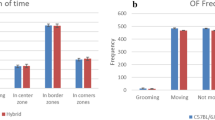Abstract
The purpose of the study was to develop a battery of tests to study social and cognitive impairments for behavioral phenotyping of aged experimental animals with physiological neurodegeneration. Male outbred CD1 mice used for the study were divided into two groups: group 1 consisted of 12-month-old male mice (physiological aging) and group 2 consisted of 2-month-old male mice (control group). A social recognition 5-trial test, elevated plus maze test (EPM), open field test, light-dark box test, and fear conditioning were used for estimation of the neurological state of experimental animals. We found that aged male mice exhibited lower interest in female mice in the social 5-trial task as compared to young male mice. Increased anxiety was observed in the group of aging mice in the EPM and light-dark box tests as compared to the control group. Lower locomotor activity and increased anxiety were found in the aging rats studied in the open field test. Physiological neurodegeneration was related to impaired associative learning and memory in the group of aging mice, which were observed in fear conditioning; particularly, consolidation of fear memory was dramatically suppressed. Analysis of behavioral factors, social interactions, and anxiety confirmed a model of agerelated neurodegeneration in the aged mice. We suggest that studies on animal behavior in the open field test, light-dark box test, and fear conditioning is the most informative approach for detection of neurological impairments, including deficits of social contacts and interaction, limitation of interests, and increased anxiety, in aging mice. This allows us to get new basic data on behavioral alterations in a model of age-related neurodegeneration and to develop novel therapeutic strategies for the treatment of age-related brain pathology.
Similar content being viewed by others
References
Bishop, N.A., Lu, T., and Yankner, B.A., Neural mechanisms of ageing and cognitive decline, Nature, 2010, vol. 464, no. 7288, pp. 529–535.
Brunzell, D.H. and Kim, J.J., Fear conditioning to tone, but not to context, is attenuated by lesions of the insular cortex and posterior extension of the intralaminar complex in rats, Behav. Neurosci., 2001, vol. 115, no. 2, pp. 365–375.
Crawley, J.N. and Paylor, R., A proposed test battery and constellations of specific behavioral paradigms to investigate the behavioral phenotypes of transgenic and knockout mice, Horm. Behav., 1997, vol. 31, no. 3, pp. 197–211.
Crawley, J.N., What’s Wrong with My Mouse? Behavioral Phenotyping of Transgenic and Knockout Mice, New York: Wiley, 2000.
Crawley, J., Behavioral phenotyping strategies for mutant mice, Neuron, 2008, vol. 57, pp. 809–818.
Debiec, J., Díaz-Mataix, L., Bush, D.E., et al., The amygdale encodes specific sensory features of an aversive reinforce, Nat. Neurosci., 2010, vol. 13, no. 5, pp. 536–537.
Fitch, T., Adams, B., Chaney, S., et al., Force transducer based movement detection in Fear conditioning in mice: a comparative analysis, Hippocampus, 2002, vol. 12, pp. 4–17.
Fox, J.G., Barthold, S., Davisson, M., et al., The Mouse in Biomedical Research: Normative Biology, Husbandry, and Models, San Diego, CA: Academic, 2007, 2nd ed.
Komada, M., Takao, K., and Miyakawa, T., Elevated plus maze for mice, J. Vis. Exp., 2008, vol. 22, p. 1088.
Levin, E.D. and Buccafusco, J.J., Animal Models of Cognitive Impairment, Boca Raton, FL: CRC, 2006.
McIlwain, K.L., Merriweather, M.Y., Yuva-Paylor, L.A., et al., The use of behavioral test batteries: effects of training history, Physiol. Behav., 2001, vol. 73, no. 5, pp. 705–717.
Oler, J.A., Ramos, R.L., Penley, S.C., et al., Hippocampal and amygdalar involvement in discriminatory place learning, Neuroscience, 2005, vol. 132, no. 1, pp. 1–12.
Oliver, P.L. and Davies, K.E., New insights into behavior using mouse ENU mutagenesis, Hum. Mol. Genet., 2012, vol. 21, pp. 72–81.
Pennington, C., Hayre, A., Newson, M., et al., Functional cognitive disorder: a common cause of subjective cognitive symptoms, J. Alzheimer’s Dis., 2015, vol. 48, no. 1, pp. 19–24.
Phillips, R.G. and LeDoux, J.E., Differential contribution of amygdala and hippocampus to cued and contextual fear conditioning, Behav. Neurosci., 1992, vol. 106, no. 2, pp. 274–285.
Pogorelov, V.M., Rodriguiz, R.M., Inscol, M.L., et al., Novelty seeking and stereotypic activation of behavior in mice with disruption of the Dat1 gene, Neuropsychopharmacology, 2005, vol. 30, no. 10, pp. 1818–1831.
Rudy, J.W. and O’Reilly, R.C., Contextual fear conditioning, conjunctive representations, pattern completion, and the hippocampus, Behav. Neurosci., 1999, vol. 113, pp. 867–880.
Satoh, Y., Endo, S., Ikeda, T., et al., Extracellular signal- regulated kinase 2 (ERK2) knockdown mice show deficits in long-term memory; ERK2 has a specific function in learning and memory, J. Neurosci., 2007, vol. 27, no. 40, pp. 10765–10776.
Shoji, H., Takao, K., Hattori, S., et al., Contextual and cued fear conditioning test using a video analyzing system in mice, J. Vis. Exp., 2014, vol. 85. doi 10.3791/50871
Shoji, H., Takao, K., Hattori, S., et al., Age-related changes in behavior in C57BL/6J mice from young adulthood to middle age, Mol. Brain, 2016, vol. 9. doi 10.1186/s13041-016-0191-9
Takao, K. and Miyakawa, T., Light/dark transition test for mice, J. Vis. Exp., 2006, vol. 1. doi 10.3791/104
Takao, K., Yamasaki, N., and Miyakawa, T., Impact of brain-behavior phenotyping of genetically-engineered mice on research of neuropsychiatric disorders, Neurosci. Res., 2007, vol. 58, no. 2, pp. 124–132.
Yonezaki, K., Uchimoto, K., Miyazaki, T., et al., Post anesthetic effects of isoflurane on behavioral phenotypes of adult male C57BL/6J mice, PLoS One, 2015, vol. 10, no. 3. doi 10.1371/journal.pone.0122118
Author information
Authors and Affiliations
Corresponding author
Additional information
Original Russian Text © Ya.V. Gorina, Yu.K. Komleva, O.L. Lopatina, V.V. Volkova, A.I. Chernykh, A.A. Shabalova, A.A. Semenchukov, R.Ya. Olovyannikova, A.B. Salmina, 2017, published in Uspekhi Gerontologii, 2017, Vol. 30, No. 1, pp. 49–55.
Rights and permissions
About this article
Cite this article
Gorina, Y.V., Komleva, Y.K., Lopatina, O.L. et al. The battery of tests for experimental behavioral phenotyping of aging animals. Adv Gerontol 7, 137–142 (2017). https://doi.org/10.1134/S2079057017020060
Published:
Issue Date:
DOI: https://doi.org/10.1134/S2079057017020060




